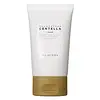What's inside
What's inside
 Key Ingredients
Key Ingredients

No key ingredients
 Benefits
Benefits

 Concerns
Concerns

 Ingredients Side-by-side
Ingredients Side-by-side

Cetyl Ethylhexanoate
EmollientGlycerin
HumectantPentylene Glycol
Skin ConditioningHydrogenated Lecithin
EmulsifyingNiacinamide
SmoothingMacadamia Ternifolia Seed Oil
EmollientPEG-50 Shea Butter
EmulsifyingLimnanthes Alba Seed Oil
Skin ConditioningSqualane
EmollientCarbomer
Emulsion Stabilising1,2-Hexanediol
Skin ConditioningTromethamine
BufferingPanthenol
Skin ConditioningSodium Carbomer
Emulsion StabilisingErythritol
HumectantTrehalose
HumectantBetaine
HumectantButylene Glycol
HumectantCaprylhydroxamic Acid
Caprylic/Capric Triglyceride
MaskingAdenosine
Skin ConditioningLavandula Spica Flower Oil
MaskingXanthan Gum
EmulsifyingOzonized Olive Oil
Skin ConditioningHydroxyethylcellulose
Emulsion StabilisingOrange Roughy Oil
Skin ConditioningMadecassoside
AntioxidantBiosaccharide Gum-1
HumectantAsiaticoside
AntioxidantMalt Extract
Skin ProtectingAsiatic Acid
Skin ConditioningButter Extract
EmollientGlycyrrhiza Glabra Leaf Extract
Skin ConditioningCeramide AP
Skin ConditioningChamomilla Recutita Flower Extract
MaskingLinoleic Acid
CleansingEthylhexylglycerin
Skin ConditioningSodium Hyaluronate
HumectantLinolenic Acid
CleansingCetyl Ethylhexanoate, Glycerin, Pentylene Glycol, Hydrogenated Lecithin, Niacinamide, Macadamia Ternifolia Seed Oil, PEG-50 Shea Butter, Limnanthes Alba Seed Oil, Squalane, Carbomer, 1,2-Hexanediol, Tromethamine, Panthenol, Sodium Carbomer, Erythritol, Trehalose, Betaine, Butylene Glycol, Caprylhydroxamic Acid, Caprylic/Capric Triglyceride, Adenosine, Lavandula Spica Flower Oil, Xanthan Gum, Ozonized Olive Oil, Hydroxyethylcellulose, Orange Roughy Oil, Madecassoside, Biosaccharide Gum-1, Asiaticoside, Malt Extract, Asiatic Acid, Butter Extract, Glycyrrhiza Glabra Leaf Extract, Ceramide AP, Chamomilla Recutita Flower Extract, Linoleic Acid, Ethylhexylglycerin, Sodium Hyaluronate, Linolenic Acid
Water
Skin ConditioningGlycerin
HumectantCaprylic/Capric Triglyceride
MaskingButylene Glycol
HumectantCetyl Alcohol
EmollientGlyceryl Stearate Se
EmulsifyingStearyl Alcohol
EmollientParaffinum Liquidum
EmollientCetearyl Ethylhexanoate
EmollientCarbomer
Emulsion StabilisingMethylparaben
PreservativeImidazolidinyl Urea
PreservativeCeteareth-20
CleansingPropylparaben
PreservativeParfum
MaskingStearic Acid
CleansingDimethicone
EmollientDisodium EDTA
Palmitic Acid
EmollientSodium Hydroxide
BufferingIsopropyl Myristate
EmollientLinalool
PerfumingHexyl Cinnamal
PerfumingCitronellol
PerfumingArachidic Acid
CleansingLauric Acid
CleansingMyristic Acid
CleansingHydroxycitronellal
PerfumingMel
EmollientSine Adipe Lac
Skin ConditioningPhenoxyethanol
PreservativeCI 47005
Cosmetic ColorantCI 14700
Cosmetic ColorantWater, Glycerin, Caprylic/Capric Triglyceride, Butylene Glycol, Cetyl Alcohol, Glyceryl Stearate Se, Stearyl Alcohol, Paraffinum Liquidum, Cetearyl Ethylhexanoate, Carbomer, Methylparaben, Imidazolidinyl Urea, Ceteareth-20, Propylparaben, Parfum, Stearic Acid, Dimethicone, Disodium EDTA, Palmitic Acid, Sodium Hydroxide, Isopropyl Myristate, Linalool, Hexyl Cinnamal, Citronellol, Arachidic Acid, Lauric Acid, Myristic Acid, Hydroxycitronellal, Mel, Sine Adipe Lac, Phenoxyethanol, CI 47005, CI 14700
 Reviews
Reviews

Ingredients Explained
These ingredients are found in both products.
Ingredients higher up in an ingredient list are typically present in a larger amount.
Butylene Glycol (or BG) is used within cosmetic products for a few different reasons:
Overall, Butylene Glycol is a safe and well-rounded ingredient that works well with other ingredients.
Though this ingredient works well with most skin types, some people with sensitive skin may experience a reaction such as allergic rashes, closed comedones, or itchiness.
Learn more about Butylene GlycolThis ingredient is an emollient, solvent, and texture enhancer. It is considered a skin-softener by helping the skin prevent moisture loss.
It helps thicken a product's formula and makes it easier to spread by dissolving clumping compounds.
Caprylic Triglyceride is made by combining glycerin with coconut oil, forming a clear liquid.
While there is an assumption Caprylic Triglyceride can clog pores due to it being derived from coconut oil, there is no research supporting this.
Learn more about Caprylic/Capric TriglycerideCarbomer is a polymer of acrylic acid. Its main role is to create a gel consistency.
A high amount of carbomer can cause pilling or balling up of products. Don't worry, most products contain 1% or less of carbomer.
Glycerin is already naturally found in your skin. It helps moisturize and protect your skin.
A study from 2016 found glycerin to be more effective as a humectant than AHAs and hyaluronic acid.
As a humectant, it helps the skin stay hydrated by pulling moisture to your skin. The low molecular weight of glycerin allows it to pull moisture into the deeper layers of your skin.
Hydrated skin improves your skin barrier; Your skin barrier helps protect against irritants and bacteria.
Glycerin has also been found to have antimicrobial and antiviral properties. Due to these properties, glycerin is often used in wound and burn treatments.
In cosmetics, glycerin is usually derived from plants such as soybean or palm. However, it can also be sourced from animals, such as tallow or animal fat.
This ingredient is organic, colorless, odorless, and non-toxic.
Glycerin is the name for this ingredient in American English. British English uses Glycerol/Glycerine.
Learn more about Glycerin